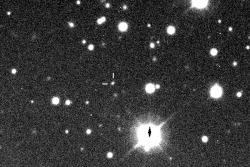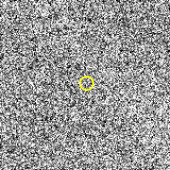 Kalyke imaged by the Canada-France-Hawaii Telescope in December 2001 | |
| Discovery [1] | |
|---|---|
| Discovered by | Scott S. Sheppard David C. Jewitt Yanga R. Fernandez Eugene A. Magnier |
| Discovery site | Mauna Kea Observatory |
| Discovery date | 23 November 2000 |
| Designations | |
Designation | Jupiter XXIII |
| Pronunciation | /ˈkælɪkiː/[2] |
Named after | Καλύκη Kalykē |
| S/2000 J 2 | |
| Adjectives | Kalykean /kælɪˈkiːən/ |
| Orbital characteristics [3] | |
| Epoch 27 April 2019 (JD 2458600.5) | |
| Observation arc | 16.34 yr (5,967 days) |
Semi-major axis | 0.1614179 AU (24,147,770 km) |
| Eccentricity | 0.3028225 |
| –766.61 d | |
| 63.16063° | |
| 0° 28m 10.57s / day | |
| Inclination | 165.93730° (to ecliptic) |
| 132.43876° | |
Argument of perihelion | 323.78885° |
| Satellite of | Jupiter |
| Group | Carme group |
| Physical characteristics | |
Mean diameter | 6.9±1.3 km[4] |
| Albedo | 0.029±0.014[4] |
Apparent magnitude | 21.8[5] |
Absolute magnitude (H) | 15.4[3] |
Kalyke /ˈkælɪkiː/, also known as Jupiter XXIII, is a retrograde irregular satellite of Jupiter. It was discovered by a team of astronomers from the University of Hawaii led by Scott S. Sheppard et al. in 2000, and given the temporary designation S/2000 J 2.[6][1]
From infrared thermal measurements by the WISE spacecraft, Kalyke's albedo is measured at 2.9%, corresponding to a diameter of 6.9 kilometres.[4] It orbits Jupiter at an average distance of 23,181,000 km in 721.021 days, at an inclination of 166° to the ecliptic (165° to Jupiter's equator), in a retrograde direction and with an eccentricity of 0.2140.
It was named in October 2002 after the Greek mythological figure Kalyke or Calyce.[7]

It belongs to the Carme group, made up of irregular retrograde moons orbiting Jupiter at a distance ranging between 23 and 24 Gm and at an inclination of about 165°.
References
- ^ a b MPEC 2001-A28: S/2000 J 2, S/2000 J 3, S/2000 J 4, S/2000 J 5, S/2000 J 6 2001 January 5 (discovery and ephemeris)
- ^ as 'Calyce' in Noah Webster (1884) A Practical Dictionary of the English Language
- ^ a b "M.P.C. 115890" (PDF). Minor Planet Circular. Minor Planet Center. 27 August 2019.
- ^ a b c Grav, T.; Bauer, J. M.; Mainzer, A. K.; Masiero, J. R.; Nugent, C. R.; Cutri, R. M.; et al. (August 2015). "NEOWISE: Observations of the Irregular Satellites of Jupiter and Saturn". The Astrophysical Journal. 809 (1): 9. arXiv:1505.07820. Bibcode:2015ApJ...809....3G. doi:10.1088/0004-637X/809/1/3. S2CID 5834661. 3.
- ^ Sheppard, Scott. "Scott S. Sheppard - Jupiter Moons". Department of Terrestrial Magnetism. Carnegie Institution for Science. Retrieved 26 November 2020.
- ^ IAUC 7555: Satellites of Jupiter Archived 2002-09-16 at the Wayback Machine 2001 January 5 (discovery)
- ^ IAUC 7998: Satellites of Jupiter 2002 October 22 (naming the moon)